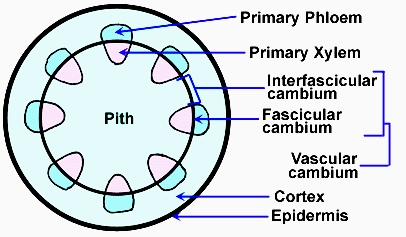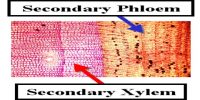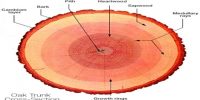Formation of cambium ring:
Cambium is a meristem that increases the girth of stems and roots by producing additional xylem and phloem. The intrafascicular cambium, as well as the cells of the medullary rays which are lying along the line of the fascicular cambium, also becomes meristematic. The intrafascicular and interfascicular cambia form a ring which separates the primary xylem and primary phloem and is known as cambium ring.
It is the first step of secondary growth.
(i) At the beginning of secondary growth, few parenchyma cells lying between two adjacent patches of fascicular cambium of vascular bundles become meristematic and produce interfascicular cambium.
(ii) The interfascicular cambium joins the fascicular cambium on both sides and forms a complete cambium ring. A cambium which is present inside the vascular bundle is called intrafascicular cambium. This is a type of primary meristem.
(iii) and interfascicular cambium is cooperatively known as vascular cambium. Vascular cambium is produced in the shape of a total ring which is made up of a single layer of cells.
(iv) Cambium ring is the lateral meristem. At first, the parenchymatous cells of the modularly rays in a line with cambium become meristematic. The cells of medullary rays become meristematic to form interfascicular cambium which is secondary lateral meristem.

Fig: cambium ring.
Formation of Cambium ring the strip of cambium present between xylem and phloem of a vascular bundle is known as fascicular or vascular cambium. The cambial ring gives increase to secondary tissues like secondary xylem and the secondary phloem in the stellar region. The interfascicular cambium joins with the strips of intrafascicular cambium to form the total cambial ring. These secondary cells are formed towards the outer and inner sides consistently forming a compact cylinder of secondary tissue.
Functions:
The functions are to produce;
Types
- Intrafascicular Cambium: It is primary in origin, present in between primary phloem and primary xylem.
- Fascicular Cambium: It is a true secondary meristem. It originates from parenchyma cells of modularly rays region. It lies in between the vascular bundles.
- Vascular Cambium Ring: Both intrafascicular and Fascicular cambium joins together and forms cambium ring.
The activity of Cambial Ring: The cambial ring becomes active and starts cutting off new cells; both on the inner and the outer sides. The cells which are cut off towards the pith mature into secondary xylem. The cambium is generally more dynamic on the inner side than on the outer side.













